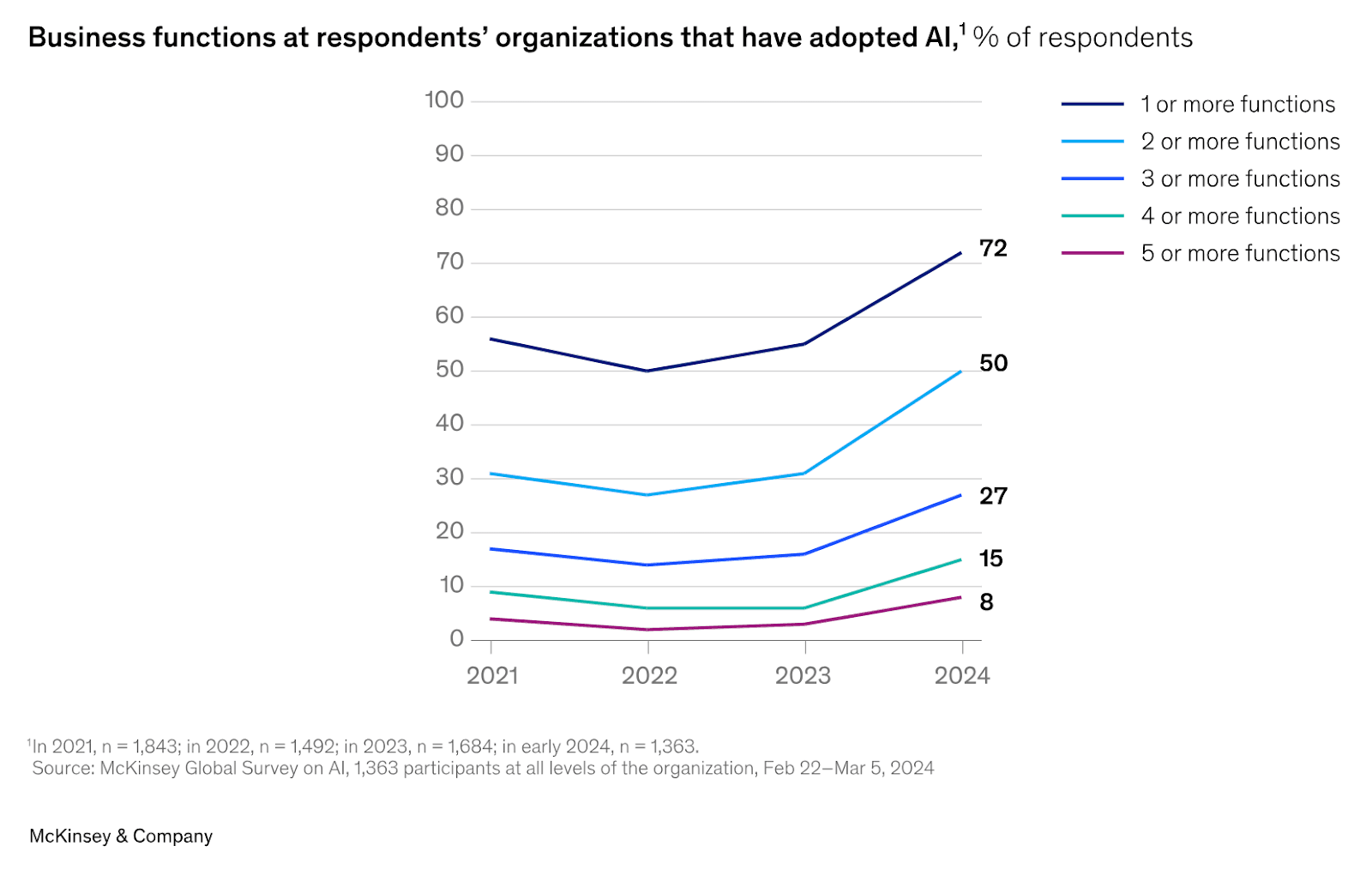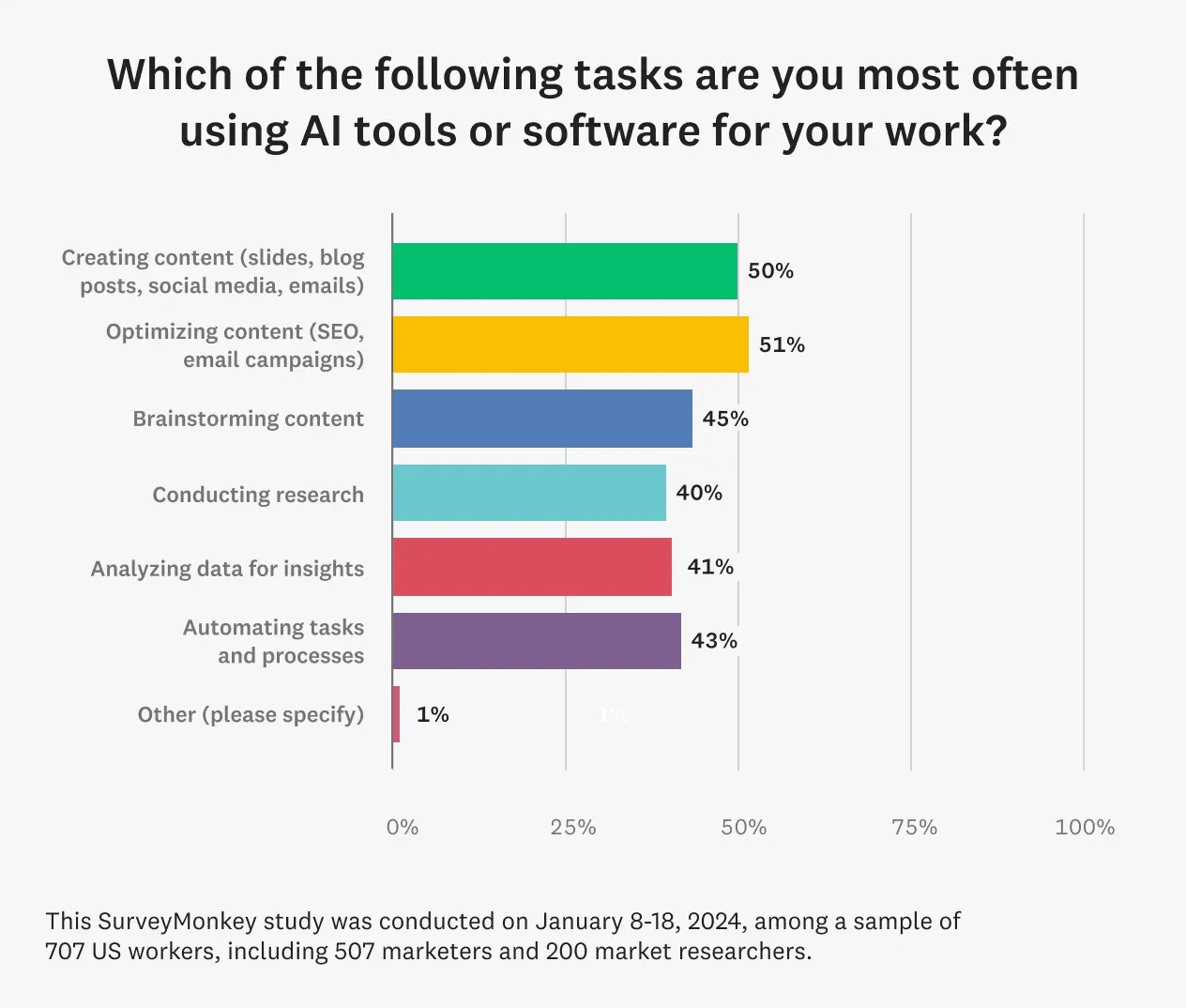Artificial intelligence statistics show that AI is becoming an essential part of everyday life and business. While it’s not quite like what we see in sci-fi movies, AI is already powering tools that help professionals and small business owners work smarter, automate tasks, and boost efficiency.
Understanding AI’s impact starts with the numbers. These statistics highlight how businesses and individuals are using AI to save time, streamline operations, and drive innovation.
Read on to discover key artificial intelligence stats and how AI is shaping the future of work and business.
5 AI Stats That Will Change The Way You Think About Artificial Intelligence
- AI can save workers up to 200 hours per year. Within one year of using AI, employees can reclaim four hours per week, increasing to 12 hours per week — or 600 hours per year — by year five.
- 72% of businesses now use AI in at least one area. Nearly three-quarters of companies have integrated AI into their operations, with half using it in multiple areas.
- Small businesses using AI are 23% more likely to increase profits. AI-driven automation and insights are helping small businesses streamline operations and boost revenue.
- Most marketers are self-teaching AI skills. 81% learn from articles and videos, 76% experiment with AI tools directly, and 73% learn from peers.
- Businesses rely on AI to improve content, engagement, and automation. 55% use AI chatbots for lead generation, 54% analyze social media sentiment, and 47% provide personalized recommendations.
#1. The Use of AI Could Free Up to 200 Hours of Time per Worker in 2025
The goal of artificial intelligence is to make our jobs easier — and data shows we’re well on our way to achieving that.
Thomson Reuters put together a survey to discover the impact of AI on the future of professionals and discovered that the use of AI tools will continue to put more hours back into the everyday professional’s day.
The data gathered shows that the use of AI tools could:
- Within one year of adoption, AI can save workers an average of four hours per week.
- By year three, that number jumps to eight hours per week.
- After five years, AI could free up 12 hours per week, or 600 hours per worker annually.

Source: Thomson Reuters
That means within the first year of adopting the use of AI tools in your team’s work processes, your team could free up to 200 hours of time per person.
And if you continue to use AI, that’ll increase to 400 hours after three years and 600 hours after five years.
By letting AI handle some of the more banal tasks, you’re freeing up your more valuable human workforce to focus on the tasks that only humans can.
For small business owners, this means spending less time on administrative work and more time growing their business. Whether it’s automating invoices, managing customer inquiries, or quickly generating a professional website with tools like Durable, AI allows you to focus on what matters most.
Let our AI website builder work its magic so your team doesn’t have to spend time creating and customizing an entire website — it’s done for you in minutes.
Ready to Get Started?
#2. 72% of Organizations Have Adopted the Use of AI in at Least One Business Function
According to a McKinsey survey, nearly three in four organizations across the globe have adopted the use of AI tools for at least one business function.
Half of businesses are using AI for at least two functions, and just over a quarter are using it for three or more functions.

Source: McKinsey & Company
As you can see, the use of AI has vastly increased across the board from 2023 to 2024, and we can expect to see that same kind of growth throughout 2025 as well.
Now let’s get a little more niche. While the above refers to any business function, another survey found that 87% of marketing professionals are using AI within their daily jobs.
This comes as no surprise given Deloitte’s State of Gen AI report found that marketing and customer service are two of the most popular uses for generative AI tools.
For small business owners, this trend is an opportunity — not a challenge. AI is no longer just for large corporations; it’s now accessible to entrepreneurs looking to streamline their workflows, enhance customer interactions, and optimize their marketing efforts.
The earlier you integrate AI into your processes, the more you can future-proof your business.
#3. 23% of Small Businesses Using AI Are More Likely To See an Increase in Profit
AI isn’t just about working faster — it’s also about working smarter. According to the U.S. Chamber of Commerce, 23% of small businesses that use AI are more likely to see an increase in profits compared to those that don’t.
What does this mean for you? It means AI isn’t just a trend — it’s a tool that’s already helping small businesses boost their bottom line. Whether you're a solopreneur or running a growing team, AI can help you do more with less, making your business more efficient and profitable.
For example, AI-powered tools can help streamline marketing by identifying the best-performing content, automating ad placements, and even assisting with social media engagement. It can also improve customer service through chatbots that provide instant responses, ensuring customers always get the information they need — even outside of business hours.
Beyond marketing and customer service, AI can help with administrative tasks like invoicing, bookkeeping, and inventory management, freeing up valuable time for strategic decision-making and business development.
The best part? You don’t need to be a tech expert to start using AI — many tools, like Durable’s AI Website Builder, are designed to be user-friendly and intuitive.
Think of AI as your digital assistant — helping you make smarter decisions, optimize your operations, and stay ahead of the competition without adding extra hours to your workload. The businesses that embrace AI today will be the ones setting the pace in the future.
Want to take the first step in using AI to grow your business? Generate your website with Durable now →
#4. The Vast Majority of Marketers Are Teaching Themselves How To Use AI
When asked how marketers are learning how to use AI, the vast majority of them appear to lean on self-taught methods.
- 81% of marketers are self-teaching AI through articles and videos.
- 76% explore AI tools hands-on to understand their capabilities.
- 73% learn from peers to discover best practices.

Just 33% engage with industry professionals or consultants, and only 10% have company training.
For small business owners, this highlights an important takeaway: You don’t need a technical background to start using AI.
This is great news — it shows that AI learning is accessible and practical. You don’t need a formal training program to start integrating AI into your daily tasks. Many AI tools are designed to be intuitive, allowing you to learn as you go.
While structured training can certainly help, the fact that so many professionals are successfully self-learning AI proves that you can take charge of your own AI journey. By staying curious, experimenting with AI tools, and leveraging online resources, you can gain valuable AI skills that set your business apart.
#5. Small Businesses Are Using AI To Optimize Marketing, Automate Tasks, and Boost Creativity
How can you start using AI in your small business and marketing processes? SurveyMonkey found that some of the top ways marketers are using AI include content creation and optimization, brainstorming, researching, automation, and analyzing data.
- 55% of marketers use AI chatbots for lead generation.
- 54% analyze social media sentiment to understand customer trends.
- 47% offer personalized product or service recommendations.

Source: Survey Monkey
For small business owners, this means AI isn't just about automation — it’s about smarter, more strategic decision-making. By leveraging AI tools, businesses can engage with customers more effectively, refine their marketing strategies, and personalize interactions at scale.
Whether you're using AI for content creation, customer support, or marketing analytics, it can help you maximize impact while reducing workload. The result? More time for high-value activities that drive business growth and keep your brand competitive.
What AI Means for Small Businesses
Artificial intelligence isn’t about replacing jobs — it’s about empowering entrepreneurs to achieve more with less effort. AI can help you:
- Save time on repetitive tasks
- Improve customer service and engagement
- Optimize marketing efforts for better ROI
- Automate processes to scale your business
AI can help your team save time on banal tasks, opening them up to more important or strategic work. It can also help your business save money on more expensive software and ensure every role on your team impacts your company’s bottom line.
Discover how Durable’s AI tools can quickly set up your small business, allowing you to focus on growth and generating revenue in just minutes.

